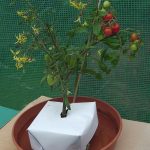Emptying out a pot of perlite to pot on, is almost impossible – it’s too messy and the same applies to coco! In other words, potting on as we would with soil, isn’t really practical with most hydroponic media.
However, the great thing about growing hydroponically is that we don’t need a lot of volume to grow in – a smaller pot size of perlite, coco or block of rockwool works fine – especially if we are only growing a dwarf tomato variety.
This means that our first transplanting, from seedling to pot, will be our final transplanting!

I suggest choosing one of four media
- A rockwool block 3 inch square large hole – they also make 4 inch blocks if you prefer.
- A 4 or 5 inch pot of perlite
- As above using vermiculite
- As above using coco – coir, this can be bought in dehydrated blocks in value shops etc.
I use black/white plastic to keep the rockwool block light proof and the same to cover the perlite, vermiculte or coco surface in pots. Using a layer of clay pebbles on the surface of pots also helps the wet media remain light proof. This avoids the growth of algae.
Preparation
To prepare the rockwool, soak for a couple of minutes, then rinse through with water/nutrients pH adjusted (see previous weeks). Remember not to squeeze the rockwool.
Coco can be rehydrated with water/nutrients, with the pH adjusted.
Transplant the seedling into the perlite or vermiculite before adding water/nutrients pH adjusted.
Nutrients
The nutrients can be Rootit First Feed or the 1ml in half a litre of water using the Wilco’s feed.
Transplanting the seedlings can be done anytime over the next two or three weeks. Whatever media the seedling is growing in before transplanting, it’s best not to expose the roots to light. So, when roots start growing out of the jiffy or sponge, it’s time to transplant!
Note
Although I set out on this hydroponic grow-along with the idea of making it as inexpensive as possible, I will suggest one or two additions that should produce the best results. However, the budget method works fine too!
Recap …
Transplant into final position over the next few weeks. Maybe sow a few more seeds and try all four methods above!
A pH Test Kit
One really useful aid is a pH tester kit. The Essentials pH Test Kit Narrow Spectrum is very good value and accurate!
It lasts a long time and I know it is accurate because I’ve tested it against my electronic pH tester. The Narrow Spectrum version is best for our requirements.

KENNETH HOLMES
Thanks Nick, this is a vey interesting exercise for me. Although I have done lettuces in a dwc I didn’t think it possible to grow tomatoes hydroponically.
Ken Holmes
Transplanted three into 3 inch groden blocks and the remaining three into the red plastic cups with perlite. The latter is normally used by the pepper fanatics on you tube. Will fed these from the bottom in the second cup. I have use the Root-it first feed as the nutrient. When do you think I should change to the Wilco nutrient. I already have a Essentials PH meter so I have used that when estabishing the PH.
Nick
Hi Ken, I usually feed with Rootit for about six weeks after germination, then go on to an adult feed – in our case the Wilco feed.
In my experience, nutrients for soil are about half the strength of nutrients for hydroponic use – that is, the recommended dosage. Therefore the recommended wilco dose is half the strength that we will need for our plants grown hydroponically, so when the time comes to feed the adult stuff, we’ll double the dose.
We’ll need an EC of just under 2.0 to begin with, for the wilco feed, so it will be interesting to measure it – I haven’t yet!
Over the life of the tomato plant we will increase the EC – up to 3.5 – to encourage fruiting. Low EC encourages rapid leaf growth.
I’ll keep you updated on the EC side of things!